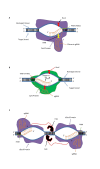Nuclease-Mediated Gene Therapies for Inherited Metabolic Diseases of the Liver
- PMID: 29259521
- PMCID: PMC5733857
Nuclease-Mediated Gene Therapies for Inherited Metabolic Diseases of the Liver
Abstract
Inherited metabolic diseases (IMDs) of the liver represent a vast and diverse group of rare genetic diseases characterized by the loss or dysfunction of enzymes or proteins essential for metabolic pathways in the liver. Conventional gene therapy involving adeno-associated virus (AAV) serotype 8 vectors provide therapeutically high levels of hepatic transgene expression facilitating the correction of the disease phenotype in pre-clinical studies and are currently being evaluated in clinical trials for multiple IMDs. However, insertional mutagenesis and immunogenicity risks as well as efficacy limitations represent major drawbacks for the AAV system. Genome editing tools, particularly the clustered regularly interspaced short palindromic repeats (CRISPR) and CRISPR-associated protein 9 (Cas9) system, offer multiple advantages over conventional gene transfer and have the potential to further advance the promises of gene therapy. Here, we provide a critical assessment of conventional gene therapy and genome editing approaches for therapeutic correction of the most investigated metabolic liver disorders, namely familial hypercholesterolemia, hemophilia, ornithine transcarbamylase deficiency, hereditary tyrosinemia type 1, and alpha-1 antitrypsin deficiency. In addition, we elaborate on the barriers and future directions for advancing novel nuclease mediated gene therapies for IMDs.
Keywords: gene therapy; genome editing; hepatocytes; inborn errors of metabolism; inherited metabolic disease of the liver; nucleases; therapy for rare disease.
Figures




References
-
- Pampols T. Inherited metabolic rare disease. Adv Exp Med Biol. 2010;686:397–431. - PubMed
-
- Chanprasert S, Scaglia F. Adult liver disorders caused by inborn errors of metabolism: review and update. Mol Genet Metab. 2015;114(1):1–10. - PubMed
-
- Saudubray JM, Sedel F, Walter JH. Clinical approach to treatable inborn metabolic diseases: an introduction. J Inherit Metab Dis. 2006;29(2-3):261–74. - PubMed
-
- Schilsky ML. Transplantation for inherited metabolic disorders of the liver. Transplant Proc. 2013;45(2):455–62. - PubMed
-
- Arnon R, Kerkar N, Davis MK, Anand R, Yin W, Gonzalez-Peralta RP. Liver transplantation in children with metabolic diseases: the studies of pediatric liver transplantation experience. Pediatr Transplant. 2010;14(6):796–805. - PubMed
Publication types
MeSH terms
Substances
Grants and funding
LinkOut - more resources
Full Text Sources
Other Literature Sources
Medical
